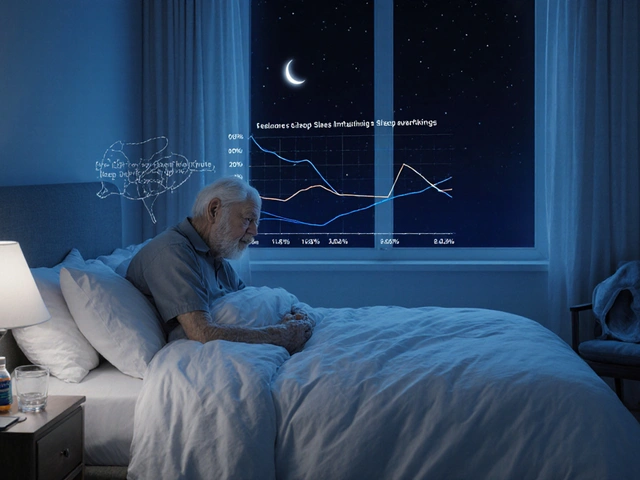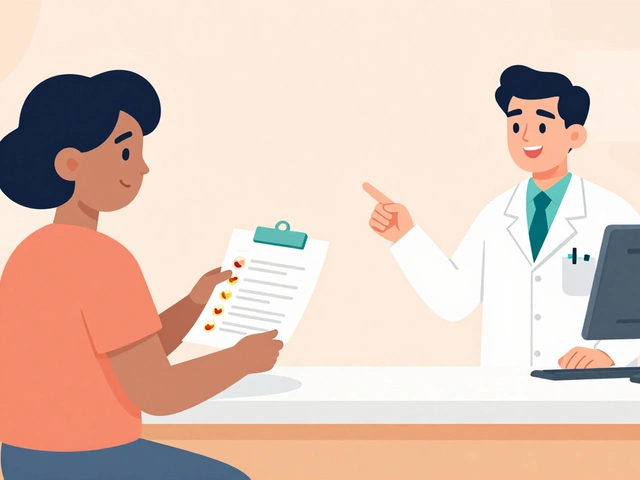
Not all antidepressants are created equal. Paxil, whose generic name is paroxetine, comes with plenty of stories—some anxious, some relieved, many in between. Is it the answer you’ve been looking for, or just one more pill with a long list of side effects nobody warned you about? If you’ve found yourself staring at the familiar little white tablet and wondering what’s really inside, you’re definitely not alone. Doctors wrote 12.5 million prescriptions for paroxetine in the U.S. in 2023 alone. It’s one of the most popular SSRIs, but also one of the most debated.
How Paxil Works and Who Uses It
Paroxetine is part of a group called selective serotonin reuptake inhibitors, or SSRIs for short. That sounds complicated, but what it really means: this medication helps your brain keep higher levels of serotonin hanging around. Serotonin is a chemical linked to mood, sleep, and feeling good. When there’s not enough, life can seem grayer, less motivating, more like wading through molasses. SSRIs, including Paxil, keep serotonin from getting sucked back into your brain cells too fast. They don’t create happiness out of thin air—but they can make it easier to bounce back.
Paxil first got FDA approval back in 1992, and it’s now available in several forms: immediate-release tablets, controlled-release tablets (often called Paxil CR), and sometimes liquid. People use Paxil for major depressive disorder, but it’s also an official go-to for social anxiety disorder, panic disorder, post-traumatic stress disorder (PTSD), generalized anxiety disorder, obsessive-compulsive disorder (OCD), and premenstrual dysphoric disorder. That’s a mouthful, but it basically means your doctor might pull it out for a range of struggles beyond just feeling sad.
Here’s an interesting wrinkle: while some SSRIs are famously activating—like fluoxetine, which can sometimes leave you feeling a little jittery—Paxil is more likely to cause sedation. For folks who can’t sleep, that’s a bonus. But for anyone already tired or low-energy, it’s worth considering before starting.
You’ll often hear that SSRIs take several weeks to really kick in, and Paxil is no exception. Some people notice small improvements—better sleep, tiny shifts in appetite or anxiety—even after a week. But most studies suggest it takes 4 to 6 weeks before the full effects settle in. Sticking it out isn’t always easy. Results in real-life use suggest about half of people who start Paxil find significant relief, which means it’s no magic bullet, but it outperforms most placebos in head-to-head trials.
Interestingly, doctors pay close attention to the specific profile of each SSRI when choosing. Paxil is sometimes avoided in younger people because, on average, it has a higher risk of side effects related to weight gain and sexual function compared to some of its competitors. But it can be a good choice in adults with anxiety who have trouble sleeping, since its sedating effects can be helpful at night.
One practical tip—if you’re starting Paxil, try to take it at the same time every day. Many find bedtime is easier, since that sedative punch can help with falling asleep. If you’re switching from another antidepressant, make sure to talk dosing and timing over with your doctor, since moving between SSRIs isn’t always straightforward.

Potential Side Effects and How to Handle Them
No prescription drug is without side effects, but Paxil draws more than its fair share of complaints. Let’s start with the numbers. According to a 2023 meta-analysis from Harvard, about 35% of users on average had at least one side effect in the first month. The top issues? Sexual dysfunction (think: loss of libido or delayed orgasm), weight gain, sleepiness, dry mouth, sweating, nausea, and sometimes increased anxiety in the first couple weeks. The flip side: some people see those effects fade with time, while for others, they never fully go away.
Here's a quick visual using stats:
| Side Effect | Percentage of Users |
|---|---|
| Sexual Dysfunction | Up to 65% |
| Sleepiness/Drowsiness | 30% |
| Weight Gain (long term) | 20-25% |
| Nausea (early phase) | 15-25% |
| Dry Mouth | 15% |
You’ll hear a lot about the sexual side effects, and not without reason. Paxil ranks near the top (along with paroxetine's sibling SSRIs) for issues in this department. If it happens to you, you’re far from alone—and there are some fixes. Tweaking the dose, adding another medication, or even using weekend drug holidays (taking breaks under a doctor’s supervision) are strategies some doctors use.
Weight gain tends to be gradual. You might notice a few pounds after several months, especially if you find yourself craving carbs. Healthy snacks, regular activity, and keeping an eye on portions really do help. If this becomes a dealbreaker, talking to your doctor about alternatives—like fluoxetine or bupropion, which are less likely to cause weight changes—makes sense.
Paxil’s sedating nature is another biggie. While this can help people with insomnia, it’s no fun if you’re already feeling sluggish. If that’s an issue, you might adjust to taking it at night or switch to another SSRI with a different profile. The dry mouth and sweating? Sipping water throughout the day and dressing in layers are simple, practical fixes. If nausea hits you right away, eat something light with your dose, and stick it out for two weeks: this usually fades fast.
One thing not enough people are warned about is Paxil’s withdrawal effects. If you suddenly stop, you might deal with dizziness, flu-like symptoms, "brain zaps," and mood swings. The term for this is SSRI discontinuation syndrome. Paroxetine is notorious for it—more so than Zoloft or Prozac. Tapering down slowly helps a lot. Never just quit cold turkey unless your doctor says it’s OK.
Are the risks worth it? For many, the answer is yes, especially if their depression or anxiety is making life unmanageable. But you should feel empowered to voice your side effect concerns. A good provider will help you weigh the options, and remind you—sticking with something that doesn’t work for you isn’t the only road.
If you run into serious symptoms—new or worsening depression, suicidal thoughts, allergic reactions—reach out for help asap. Most people get through the adjustment phase, but staying in close contact with your doctor is the smartest move.

Paxil Compared: Alternatives, Tips, and What to Expect Long-Term
You’ve probably heard of Prozac (fluoxetine), Zoloft (sertraline), Lexapro (escitalopram), and a stack of others with catchy names. So what sets Paxil apart? For starters, it’s a bit more likely to cause sedation, weight gain, and sexual side effects than most SSRIs. On the flip side, it often works fast for anxiety, especially panic attacks and social anxiety—sometimes even better than other options. That makes it a strong choice for folks with both depression and severe anxiety.
But is Paxil right for everyone? Not always. Young people under 25, women planning pregnancy, and people who take lots of other meds might be safer with something else. For example, Paxil interacts with certain blood thinners, antipsychotics, and other antidepressants. Its shorter half-life means missing even one dose can mean withdrawal symptoms by the end of a weekend. Prozac, by comparison, hangs around in your system for much longer, so you get a safety cushion if you’re forgetful.
Let’s touch on Paxil withdrawal and switching meds. Say you’ve been on it for six months, and it just isn’t working, or the side effects are a dealbreaker. Your doctor will probably suggest a slow taper, sometimes adding in a longer-acting SSRI or different antidepressant to help the transition. Sudden stops—especially on high doses—are not your friend.
There’s plenty of buzz about antidepressants “changing your personality.” The reality is, SSRIs sharpen the way your brain responds to stress and sadness. If you were a jokester, you’ll still make people laugh. If you had a stubborn streak, that won’t magically disappear. But you might notice blunted highs and lows—less drama, maybe less excitement at times, but also fewer deep lows. Some people welcome that; others find it a turn-off. If you notice emotional numbness, bring it up. Adjusting the dose or switching to a different medication with a lighter touch (like bupropion or agomelatine in Europe) could help.
If you’re in your forties or older, keep this in mind: Paxil, more than other SSRIs, can sometimes cause low sodium levels (hyponatremia), especially in women. Watch out for headaches, confusion, or feeling extra tired—worth mentioning to your doctor. And if you’re pregnant or planning, Paxil isn’t recommended, due to an increased risk of birth defects.
Tips for making Paxil work for you start with routine. Take it at the same time daily, with or without food, and don’t skip days. Keep a simple mood diary or log—this helps you and your provider spot patterns and side effects. If you drink alcohol, be extra cautious: while Paxil isn’t the most dangerous SSRI to mix with a drink, it can increase drowsiness, so moderation matters.
Stigma around antidepressants still hangs around, but don’t let web forums scare you off. Most stories online come from people who had a rough time (since folks with smooth experiences rarely feel compelled to post detailed accounts). In clinical studies, about 60% of people taking Paxil felt clear improvement compared to 40% on placebo. Still, a good connection with your doctor and real-world tracking help you make choices based on your life—not a statistic.
Don’t be shy about asking for small dose changes. Paxil comes in tablets as low as 10mg, and sometimes breaking a higher dose down to tiny, gradual steps is the key to comfort. If you ever forget a dose, take it as soon as you remember—unless it's close to the next one, in which case, skip rather than double up.
One last thing—no mental health prescription is a one-and-done fix. Pairing SSRIs like Paxil with therapy, regular sleep, social contact, and exercise doubles your chance of long-term recovery. Think of the med as a scaffolding, but you’re rebuilding the house. Want support? Ask for therapy referrals, try out guided meditation apps, or connect to local peer support communities. You’ll find a routine that feels right for you.




pooja shukla
July 18, 2025 AT 14:43Honestly, I don’t get why people fuss so much about Paxil. It’s just another antidepressant, right? Been around forever, and it works for loads of folks who actually need it. Of course, side effects aren’t a joke, but every med has them. You gotta weigh what helps more than what annoys.
People overcomplicate stuff with this one. Paroxetine simply balances serotonin, which is the key to feeling less anxious or depressed. You can’t expect a pill to fix everything overnight, so patience is key. And hey, if someone's super worried, talk to your doc before jumping ship to alternatives.
And for those who compare it to other SSRIs? Meh, they all have their quirks. Paxil might have some unique side effects, but it’s proven effective. So stop worrying and get informed instead.
Poonam Mali
July 22, 2025 AT 10:56Oh, the dramatic spectacle of Paxil's 'side effects'! It’s as if some folks expect a miraculous elixir with zero drawbacks. Let’s be real, the neurochemical labyrinth that is your brain isn’t going to be soothed by a simple serotonin tweak without some fallout. Paroxetine, with its notorious anticholinergic load, can wreak havoc if you don’t watch closely.
You think switching to alternatives like fluoxetine or sertraline magically spares you from this? Think again. Every SSRI comes with its own Faustian bargain. The vocabulary list of adverse reactions is extensive and should be approached with clinical vigilance, not wishful ignorance.
Seriously, read beyond the glossy brochures and arm yourself with knowledge before subjecting your delicate neuro-systems to trial and error.
Alan Whittaker
July 26, 2025 AT 04:23Let's not kid ourselves — Paxil isn't just a straightforward antidepressant. There’s always some hidden agenda when Big Pharma pushes these SSRIs on the masses. Ever wonder why paroxetine is so widely prescribed despite its pretty severe withdrawal syndrome and sexual dysfunction side effects? Classic move to keep patients dependent and compliant.
And the comparisons with other drugs? That’s just surface-level distraction. Behind the scenes, they tweak dosages and chemical compositions to keep us hooked while raking in profits. I’m suspicious anytime a 'straightforward' guide glosses over the darker aspects or withdrawal issues.
Best to approach with skepticism and get all facts from multiple sources, not whatever the pharma-friendly summary recommends.
Michael Waddington
July 29, 2025 AT 21:50I get why people are wary of Paxil, given how often it's singled out for side effects like weight gain or withdrawal symptoms. But honestly, not everyone experiences the worst-case scenarios. Like many SSRIs, it’s about finding the right fit for your body and brain, which can vary wildly.
The key is really open communication with your healthcare provider. Side effects can be managed or mitigated, and there are plenty of alternatives if Paxil isn't a good fit. But this article’s straightforward approach helps demystify it, which is pretty refreshing.
People freak out about medications but forget mental health is chemical too, no one-size-fits-all solution though.
HAMZA JAAN
August 2, 2025 AT 15:16Honestly, it's all about how you handle it. Paxil can be a lifesaver when used properly but it's not a free ticket to normalcy. The side effects? Yeah, they can be brutal if you’re not careful, but that goes for most antidepressants.
One thing this guide nails is the ‘realistic’ bit — knowing what to expect upfront is half the battle. If you're expecting paradise after the first dose, you're setting yourself up for disappointment and anxiety spiral. Adjusting meds always takes time.
Plus, alternatives don’t always mean better. Switching medicines mid-therapy can cause even more issues. Just be patient and careful, that's what matters.
April Rios
August 6, 2025 AT 08:43This guide is a bit of a breath of fresh air because it doesn’t sugarcoat the reality of taking Paxil. So many sources out there hype it as a miracle drug or completely scare you off with horror stories.
In reality, paroxetine is just one tool in a broader toolbox of mental health treatments. Some people do really well on it, others not so much, but understanding expected side effects and how it compares to other SSRIs is vital to making an informed choice.
And honestly, the psychological support combined with medication often makes the biggest difference. You can't think of Paxil as a cure-all but rather part of a comprehensive treatment plan.
Would love to hear more personal experiences though – anyone willing to share?
byron thierry
August 10, 2025 AT 02:10In my experience, knowledge is power, especially when it comes to Paxil. The side effect profile can be daunting, but understanding them is essential to spotting what’s manageable and what’s not. It's all about the balancing act.
The drug certainly has its controversies, but dismissing it outright ignores the evidence of many who find relief. Comparisons with other SSRIs get complicated because patient responses vary so much. Genetics, lifestyle, other conditions all factor in.
Anyone jumping on or off Paxil without expert guidance risks serious repercussions. The article does well to emphasize practical advice because clinical nuance is everything here.
bob zika
August 13, 2025 AT 19:36While the article gives a nicely simplified view of Paxil's uses and side effects, it's important to keep in mind the complexity behind antidepressant pharmacology and patient variability. Different individuals metabolize paroxetine differently, affecting both efficacy and tolerability.
I appreciate the mention of alternatives, but the choice must be personalized with professional input, as switching can sometimes exacerbate symptoms or create new side effects.
The patient-doctor dialogue is central, alongside monitoring for adverse reactions. A guide is a start, but ongoing assessment should never be overlooked.
M Black
August 17, 2025 AT 13:03Hey all! Super interesting read here! Paxil's definitely got a rep, some good, some bad. The way this guide breaks it down into what to expect is clutch because so many folks jump in without a clue and get caught off guard by side effects. It's like, duh, do your homework :)
Also, don't sleep on the importance of sticking with your doc's plan. Med changes gotta be done right, not on a whim. ✌️
Would love to know how people manage the common side effects like dry mouth or drowsiness though? Anyone got tips to share?
Sidney Wachira
August 17, 2025 AT 13:03🙄 Another shiny 'guide' trying to make us feel safe with Paxil. Listen, I’ve seen firsthand how people get trapped in this cycle of starting meds, dealing with terrible side effects, then scrambled to switch without any real control. Withdrawal from paroxetine is no joke, it leaves many in a mess way worse than their original symptoms.
This isn’t just about feeling better or worse — it’s about the slow erosion of your brain chemistry that these drugs mess with. Why isn’t anyone talking about a long-term strategy or alternatives beyond just ‘try this med’? Wake up, folks.
Don’t just take the easy route with these SSRIs; educate yourself fully before signing up for this rollercoaster.
Aditya Satria
August 17, 2025 AT 14:43I think this article provides a compact yet clear summary that can really help demystify Paxil for those new to antidepressants. It’s refreshing to see a balance between acknowledging side effects but also emphasizing the practical aspects of what to expect.
While everyone’s experience will be unique, setting realistic expectations can reduce anxiety related to medication and encourage adherence. I would advise anyone interested to combine this knowledge with open discussion with healthcare providers and loved ones.
Ultimately, mental health treatment is a collaborative process and being well informed is the foundation. Thanks for sharing this!